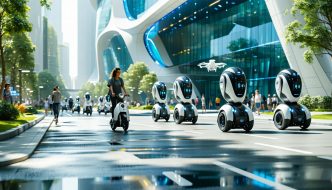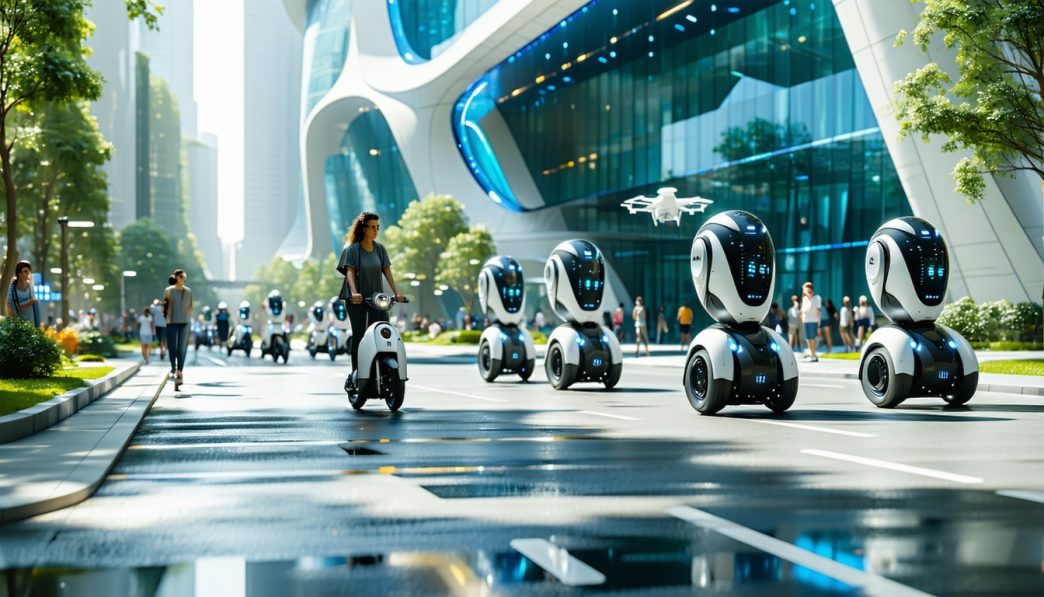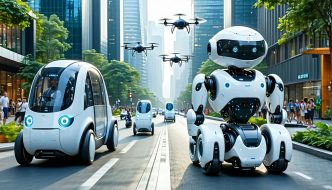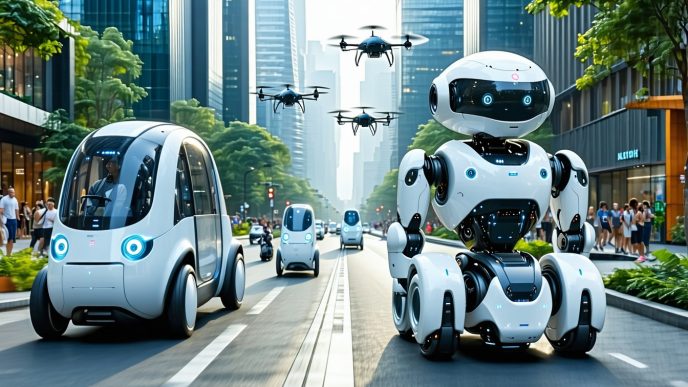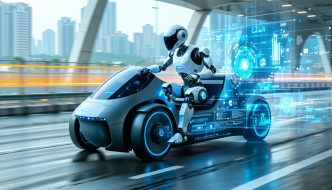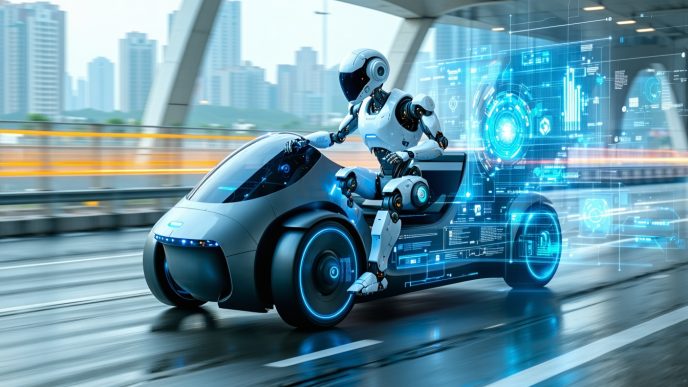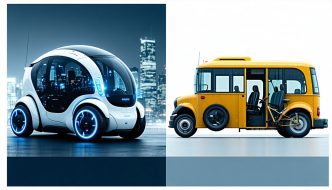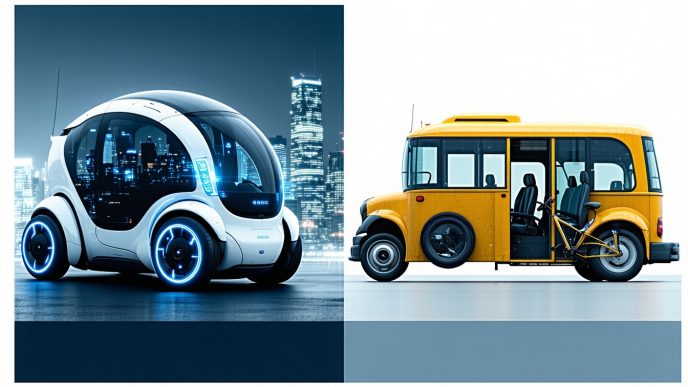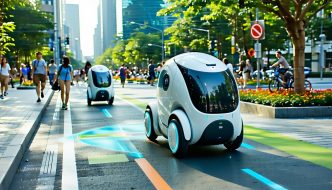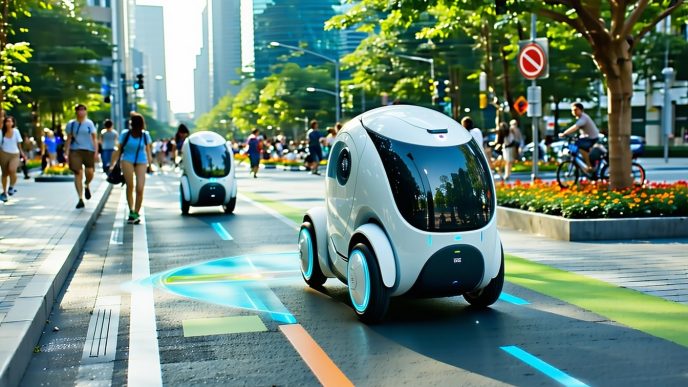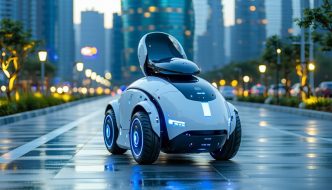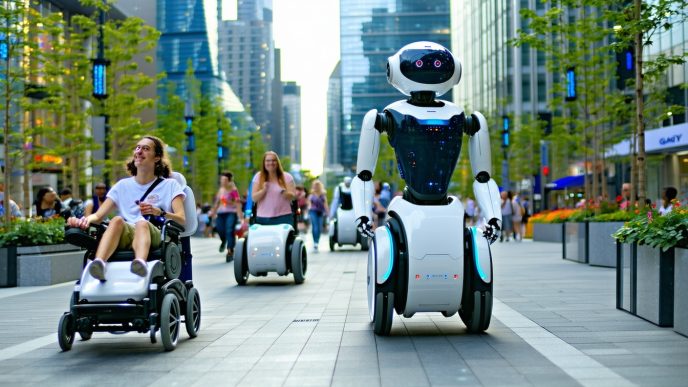Evolution of Rideable Robotics
Current State of Rideable Robotics
The current landscape of rideable robotics is characterized by a variety of innovative devices that enhance personal mobility. From electric scooters to compact e-bikes, these robots serve as efficient transportation solutions for urban dwellers. Despite their increasing popularity, they face challenges such as safety concerns, limited battery range, and varying user interface designs.
Table 1 illustrates some common types of rideable robots currently available:
| Type of Rideable Robot | Typical Speed (mph) | Battery Range (miles) | Average Weight (lbs) |
|---|---|---|---|
| Electric Scooter | 15 – 20 | 15 – 30 | 25 – 35 |
| E-bike | 20 – 28 | 20 – 50 | 40 – 60 |
| Hoverboard | 6 – 10 | 5 – 10 | 20 – 30 |
Users often look for solutions that provide convenience for short trips, making rideable robots a growing trend in urban environments. For those interested in specific applications, refer to our article on rideable robots for short trips.
Anticipated Advancements in the Next 5 to 10 Years
In the next 5 to 10 years, the future of rideable robotics is expected to undergo rapid advancements. Key developments may include improved battery technology, enhanced safety features, and greater integration with smart transportation systems.
Table 2 forecasts potential advancements in rideable robotics:
| Expected Advancement | Description | Timeline |
|---|---|---|
| Battery Technology | Long-lasting batteries with faster charging | 3 – 5 years |
| Smart Navigation Systems | AI-driven navigation for optimized routes | 5 – 7 years |
| User-Centric Design | Interfaces tailored to individual user needs | 5 – 10 years |
| Integration with Public Transit | Seamless connection with existing transit | 5 – 10 years |
Cities may begin to embrace these technologies, promoting eco-friendly transportation solutions that ensure a more sustainable urban environment. For a deeper dive into the comparative advantages of robot transportation versus traditional options, check our article on robot transportation vs traditional options.
As the sector evolves, rideable robots are poised to enhance urban mobility by providing flexibility and convenience to commuters everywhere. The focus will increasingly be on combining efficiency with user experience to cater to the dynamic needs of urban populations.
Design Innovations
The future of rideable robotics is heavily influenced by design innovations that enhance their functionality, efficiency, and user experience. Key aspects of this evolution include the use of lightweight materials, compact designs, and the integration of smart technologies.
Lightweight Materials and Construction
One significant trend is the adoption of lightweight materials in the construction of rideable robots. Using materials like carbon fiber, aluminum alloys, and advanced composites reduces the overall weight of the vehicles. This change not only improves portability but also increases energy efficiency by requiring less power to operate.
| Material Type | Weight Reduction | Efficiency Gain |
|---|---|---|
| Carbon Fiber | Up to 50% lighter than steel | Increases range by up to 20% |
| Aluminum Alloys | 30% lighter than traditional materials | Enhances battery life by 15% |
| Advanced Composites | 40% lighter than conventional options | Improves handling and maneuverability |
Compact and Foldable Designs
In urban environments, space is limited, making compact and foldable designs essential. Future rideable robots are expected to be designed for easy storage and transport. Features like collapsible frames and modular components will allow users to conveniently carry their devices on public transportation or store them at home.
These designs will cater to the needs of commuters who seek portability without compromising the robot’s functionality. The emphasis on compact designs makes them suitable for short trips, as well as daily commutes. For more insights on usage, check our article on rideable robots for short trips.
| Design Feature | Benefit | User Impact |
|---|---|---|
| Collapsible Frame | Saves space | Easier to carry and store |
| Modular Components | Customizable | Adaptable to specific needs |
| Lightweight Structure | Enhanced portability | Convenient for urban dwellers |
Integration of Smart Technologies
The integration of smart technologies plays a pivotal role in the evolution of rideable robotics. Features such as artificial intelligence (AI), machine learning, and connected interfaces will vastly improve the user experience. These innovations allow for real-time data analysis and adaptive control systems, ensuring a safer and more efficient ride.
Furthermore, the incorporation of user-friendly interfaces will enable riders to customize their experience, adjusting settings according to personal preferences. Enhanced safety mechanisms such as automated braking and obstacle detection are also part of this technological integration, ensuring a secure ride for everyone involved. For detailed insights on this aspect, see our article on robot rider interfaces.
| Technology Type | Function | Advantage |
|---|---|---|
| Artificial Intelligence | Real-time decision making | Increases safety and efficiency |
| Machine Learning | Adaptive control systems | Enhances ride comfort |
| Connected Interfaces | User customization | Improves overall satisfaction |
As the landscape of rideable robotics continues to evolve, these design innovations will shape the future of personal mobility solutions. The progress in lightweight materials, compact designs, and smart technology integration will fundamentally redefine how people navigate urban spaces. For more comparisons between rideable robots and traditional transport options, refer to our article on robot transportation vs traditional options.
Power and Energy Efficiency
As the landscape of rideable robotics evolves, power and energy efficiency are critical components that will shape the future of rideable robotics. Innovations in battery technology and sustainable power sources are paving the way for more efficient and environmentally friendly transport solutions.
Advancements in Battery Technology
Battery technology is undergoing significant advancements, leading to improvements in energy storage capacity, charging speed, and overall reliability. Future rideable robots are expected to benefit from batteries that offer higher energy densities, allowing for longer ranges and reduced charging times. This will directly impact the usability and popularity of rideable robots for various applications, particularly in urban commuting.
The table below highlights key features of emerging battery technologies for rideable robotics:
| Battery Type | Energy Density (Wh/kg) | Charge Time (hours) | Lifespan (cycles) |
|---|---|---|---|
| Lithium-ion | 150-250 | 1-4 | 500-1500 |
| Solid-state | 300-500 | 1-2 | 1000-3000 |
| Lithium-sulfur | 500-600 | 1-3 | 300-800 |
| Sodium-ion | 100-150 | 0.5-2 | 500-1000 |
These advancements will play an essential role in determining the practicality of rideable robots for short trips and daily commutes. More detailed information can be found in our article on battery range for rideable robots.
Sustainable Power Sources
The sustainability of rideable robotics does not just hinge on battery technology; alternative power sources are also crucial. Future rideable robots are expected to integrate renewable energy solutions, thus minimizing their carbon footprint. Solar panels, for example, can be incorporated into the design of rideable robots, converting sunlight into electricity for continuous charging during daylight hours.
Another notable advancement relates to the use of regenerative braking systems. These systems harness energy that would typically be lost during braking, converting it into usable power. This feature significantly enhances the overall energy efficiency of rideable robots, making them more appealing to urban commuters and tech enthusiasts alike.
| Sustainable Source | Potential Output (W) | Application |
|---|---|---|
| Solar Panels | 50-200 | Continuous charging |
| Regenerative Braking | Variable (up to 30%) | Energy recovery during stops |
Emphasizing environmentally sustainable practices will not only align with existing mobility trends but also support the broader shift towards eco-friendly transportation solutions. For more insights into the evolution of rideable robotics and their potential applications, refer to our article on transportation and rideability robots.
Enhanced User Experience
As rideable robotics continue to evolve, enhancing the user experience will be a critical aspect of their development. Safety features, connectivity, and customization options will play a pivotal role in attracting early adopters, urban commuters, and tech enthusiasts.
Improved Safety Features
Safety is a primary concern for users of rideable robots. Future advancements are expected to focus on improving stability and crash avoidance systems. Incorporating sensors and advanced algorithms will allow these robots to detect obstacles and adjust their paths in real-time. Key safety enhancements may include:
| Safety Feature | Description |
|---|---|
| Collision Detection | Sensors can identify obstacles to prevent accidents. |
| Stability Control | Advanced gyroscopic systems help maintain balance, especially on uneven terrain. |
| Emergency Stop Mechanisms | Quick-response features will allow users to halt the robot immediately in case of an emergency. |
These innovations will ensure a safer ride and increase overall user confidence in adopting rideable robotics. For additional insights into safety considerations, refer to our article on rideable robot stability and safety.
Connectivity and IoT Integration
The future of rideable robotics will also emphasize connectivity. Integration with the Internet of Things (IoT) will enhance the functionality and convenience of rideable robots. Features may include:
- Real-time Tracking: Users will be able to monitor their robot’s location via smartphones or other devices.
- Data Sharing: Rideable robots will be able to communicate with each other and infrastructure, optimizing traffic flow and reducing congestion.
- Remote Control and Monitoring: Riders can control and adjust settings through a mobile app, allowing for greater customization.
| Connectivity Feature | Benefit |
|---|---|
| Mobile App Integration | Users can monitor battery life, distance traveled, and maintenance needs. |
| Traffic Coordination | Robots can communicate with city infrastructure for efficient navigation. |
| Usage Analytics | Data collected can help improve future designs and user interfaces. |
For more details on rider interfaces, visit our article on robot rider interfaces.
Customization Options for Personalization
Future rideable robots are expected to offer users a range of customization options, allowing them to tailor their experience to suit individual preferences. This could include:
- Adjustable Settings: Users can modify speed, sensitivity, and ride modes based on personal comfort.
- Aesthetic Customization: Options for colors, designs, or patterns can allow for individual expression.
- Accessory Compatibility: Future rideable robots could support attachments like baskets or carriers for luggage and shopping.
| Customization Option | Description |
|---|---|
| Speed Settings | Users can select different modes based on their comfort level. |
| Design Choices | Personalization options for aesthetics. |
| Attachment Options | Compatibility with accessories for added functionality. |
These features will not only enhance satisfaction but also encourage broader acceptance of rideable robotics as a viable mode of transportation. For further insights on the benefits of rideable robots, explore our article on robot transportation vs traditional options.
Urban Mobility Solutions
The future of rideable robotics is set to revolutionize urban transportation. As technology continues to evolve, these innovations will significantly impact how people navigate city environments.
Impact on Urban Transportation
Rideable robots are anticipated to play a crucial role in reshaping urban mobility. By providing efficient and flexible alternatives to traditional transportation options, they promise to reduce congestion and improve air quality. The convenience of integrating rideable robotics into everyday life allows commuters to avoid traffic jams and lengthy parking searches.
The effects of rideable robotics on urban transportation can be summarized in the following table:
| Aspect | Before Rideable Robotics | After Rideable Robotics |
|---|---|---|
| Traffic Congestion | High | Lower |
| Commute Time | Longer | Shorter |
| Parking Demand | Increased | Decreased |
| Environmental Impact | Higher emissions | Reduced emissions |
The transition to rideable robotics may facilitate a shift towards more sustainable urban transport solutions.
Integration with Public Transit Systems
Rideable robots can seamlessly integrate with existing public transit systems, enhancing overall efficiency. These robots can serve as first-mile/last-mile solutions, helping commuters reach transit hubs and their final destinations. This integration could potentially decrease reliance on personal vehicles, making public transportation more accessible and appealing.
Future public transit systems may incorporate:
| Integration Feature | Description |
|---|---|
| Automated Pick-Up Points | Designated locations for rideable robots to collect passengers |
| Scheduling and Coordination | Smart technology for synchronized rides with public transit schedules |
| Ticketing Systems | Unified payment platforms to handle all transport modes |
Such innovations would encourage increased use of public transit and enhance user experience.
Last-Mile Connectivity Solutions
The advent of rideable robots offers innovative last-mile solutions. These robots can bridge the gap between public transport stations and the final location, making journeys smoother. For densely populated urban areas, rideable robots can efficiently navigate short distances, ensuring that the final leg of the trip is quick and convenient.
Last-mile connectivity can be categorized into:
| Solution Type | Example |
|---|---|
| Rideable Personal Robots | Individual devices for easy commuting |
| Shared Rideable Solutions | Community-based programs for shared mobility |
| Delivery Integration | Robots that can also deliver goods alongside passengers |
The demand for effective last-mile connectivity is growing, and rideable robotics are positioned to meet these needs, making urban travel more accessible for everyone. For more insights into the role of rideable robots, check out our article on transportation and rideability robots.
Regulatory and Cultural Shifts
As rideable robotics continues to evolve, the regulatory landscape and cultural perceptions surrounding these technologies will play a crucial role in their adoption and integration into everyday life.
Legal Frameworks and Regulations
With the rise of rideable robots, governments and regulatory bodies are developing new frameworks to ensure safe operation within urban environments. Current regulations vary significantly across regions, often addressing issues such as safety standards, operational limits, and user responsibilities.
| Regulation Aspect | Current Status | Anticipated Changes |
|---|---|---|
| Safety Standards | Varies by region | Unified safety guidelines for rideable robotics |
| Operational Limits | Weight and speed limits in many areas | Possible expansion of allowed operating parameters |
| Licensing and Registration | Minimal in some areas | Potentially mandatory registration systems for users |
These frameworks will be essential to ensure that rideable robotics do not pose risks to pedestrians or other vehicles, and considerable advocacy from users and manufacturers will help shape these regulations.
Social Acceptance and Adoption
The social acceptance of rideable robots will greatly influence their success in urban settings. As advancements continue, public perception will be driven by user familiarity and positive experiences. Factors such as exposure through media, community trials, and demonstrations will aid in changing attitudes.
Table 2 demonstrates potential factors impacting social acceptance:
| Acceptance Factor | Description |
|---|---|
| Positive Media Coverage | Highlighting successful use cases can improve perceptions |
| Community Engagement | Public trials allow communities to interact with the technology |
| Education and Awareness | Informative campaigns can address misconceptions |
As urban commuters and tech enthusiasts become more accustomed to rideable robotics, they may begin to integrate these technologies into their daily routines, leading to quicker adoption.
Cultural Influence on Rideable Robotics
Cultural attitudes towards technology and transportation will also shape the future of rideable robotics. In some cultures, innovation and technological transformations are embraced eagerly, while in others, there may be resistance to such changes rooted in tradition and lifestyle.
Important cultural influences include:
- Openness to Innovation: Societies that prioritize technological advancements may see quicker adoption rates for rideable robotics.
- Public Transportation Preferences: In areas where public transit is highly valued, there may be increased interest in integrating rideable robots into existing systems for efficient solutions.
- Environmental Consciousness: Cultures focused on sustainability may favor the development of eco-friendly rideable options, pushing manufacturers toward green technologies.
The future of rideable robotics encompasses various social, regulatory, and cultural factors that will determine how these technologies are integrated into urban life. As these shifts occur, stakeholders will need to align their strategies to foster acceptance and ensure the successful navigation of regulatory landscapes in mobility. For more insights into applications of rideable robots, see our article on transportation and rideability robots.

